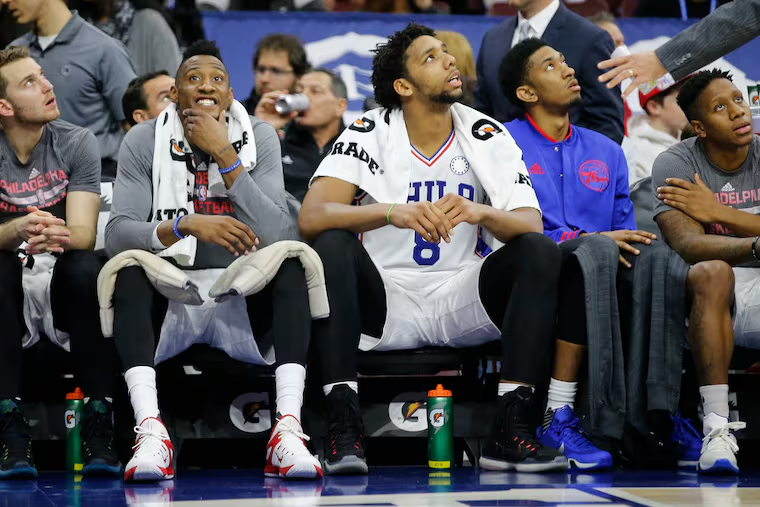Inside the Sixers: Historically bad Pistons are actually quite different from Process-era Sixers
There’s no comparison to how each franchise reached the same level of god-awfulness.

CHICAGO — The Detroit Pistons are similar to “The Process” 76ers until you realize that they really are not.
Before their 129-127 win over the Raptors on Saturday night, two days earlier they had suffered their 28th consecutive loss, tying the Sixers for the longest overall losing streak in NBA history.
With the win, the Pistons (3-29) did not replace the Sixers in the futility hall of fame.
» READ MORE: New Year’s predictions: Bryce Harper MVP? Joel Embiid title? Jalen Hurts on top? Tiger’s chances? And Torts
But if we’re being honest, there’s no comparison to how each franchise reached the same level of god-awfulness.
Yes, it’s true that Sixers were the laughingstock of the NBA while establishing their record during the end of the 2014-15 season and start of 2015-16. They concluded the 2014-15 season with 10 straight losses and began the 2015-16 season with 18 more, ending that season with a 10-72 record.
But they were trying to lose. That streak, along with their 26 consecutive during the 2013-14 were the result of a multi-season tanking known as “The Process.” That’s two streaks for a combined 54 losses.
The Sixers’ roster was intentionally loaded with fringe NBA players during the 2013-14, 2014-15, and 2015-16 seasons, as well as part of 2016-17.
The Sixers used those seasons for player development, evaluating talent, and developing a culture. In the process, they kept losing enough games to hopefully secure top draft picks. During that time, a once-proud franchise turned into the laughingstock of the NBA.
“The Process” brought a lot of pain and humiliation and a less-than-desirable place in NBA history.
The December 2015 hiring of Jerry Colangelo as Sixers’ chairman of basketball operations was an admission by the ownership group that “The Process” was not working.
General manager Sam Hinkie, who initiated The Process, resigned on April 6, 2016. At the time, the Sixers were a league-worst 10-68 with five games remaining in the infamous 2015-16 season. At that point, they were 47-195 since the start of the 2013-14 season.
Days after Hinkie’s resignation, Colangelo’s son Bryan was hired as the Sixers’ general manager and president of basketball operations.
Hinkie revealed on the Lowe Post podcast that he lost weight that season because of the Sixers’ struggles.
He saw his team open the season with 18 consecutive losses and post a 1-30 record heading into Christmas.
“I lost 20 pounds [from] November to January,” he said on the podcast.
» READ MORE: Sixers-Rockets takeaways: Marcus Morris Sr. shows why he shouldn’t be traded
The problem was the Sixers became too good at tanking and it took a toll.
Flashing forward, the Pistons came into this season with optimism.
The franchise signed Monty Williams, a former Sixers assistant and NBA Coach of the Year while leading the Phoenix Suns, this summer to a six-year, $78.5 million deal to coach the collection of up-and-coming young talent.
The team is led by standout point guard Cade Cunningham, the first pick of the 2021 NBA draft. The Pistons also have guard Jaden Ivey and forward Ausar Thompson, who were selected fifth in the 2022 and 2023 drafts, respectively.
They also acquired former Roman Catholic center Jalen Duren via a 2022 draft-night trade after the Charlotte Hornets selected him at 13th. When healthy, Duren is the starting center.
James Wiseman, one of the Pistons’ reserve centers, was the second overall pick in the 2021 draft by the Golden State Warriors. Detroit acquired him in a four-team trade on Feb. 9. Meanwhile, Marvin Bagley III, another reserve post player, was drafted second by the Sacramento Kings in 2018. He came to Detroit in a four-team trade on Feb. 10, 2022.
And the Pistons also have a sharpshooting veteran forward in Bojan Bogdanović. So there was belief that Detroit would improve upon last season’s league-worst record of 17-65.
“They were on the same wavelength of what we were doing,” Robert Covington said. “... They’re not trying to purposely lose. They have talent. It’s just that they’re young.”
» READ MORE: What’s behind the Sixers leading the NBA in an overlooked but valuable statistic
Covington would know.
The reserve forward, now in his second go-round with the Sixers, was a member of the squad that lost 28 consecutive games.
The Sixers were too good at being intentionally bad, but the Pistons have talent, and did not set out to be this futile.
“They have a lot of lottery picks,” Covington said. “We had a lot of second-year, undrafted guys.”
The fact that a coach like Williams can’t get this collection of youthfulness to win, tells you that talent wins in the NBA and that the Pistons, however earnest they might be, are now learning that they don’t have enough of it.